“A child who has become master of his acts through long and repeated exercises, and who has been encouraged by the pleasant and interesting activities in which he has been engaged, is a child filled with health and joy and remarkable for his calmness and discipline.” – Dr. Maria Montessori
What you introduce your baby to at first means a lot in regard to their future development. While you do not need a ton of stuff for up to 6 or even 12 months of age, you can surely make toys purposeful.
Once your baby grows up, check out my Montessori guides for toddlers and preschoolers, as well as practical items, to help kids of any age include Montessori at home.
Why Are Montessori Toys Wooden?
Montessori toys principle is that they need to be made of natural materials (metal, cotton, wool, wood) – not cheap plastic. Many essential things for babies are made of plastic, so there’s no need to get more of it when it comes to toys.
They don’t have to be made of wood, but most are. They are natural, elegant, and very simple, with no-buzzing, lights, or forced sounds.
You want to avoid cluttering your child’s mind and allow her or him to fully concentrate on figuring out the toy and mastering a new skill.

Can your baby or toddler enjoy Montessori toys? ABSOLUTELY!
Age 0-3 is when your baby or toddler has an absorbent mind, that learns by itself. That is why Maria Montessori said that “especially at the beginning of life must we, therefore, make the environment as interesting and attractive as we can.”
What are the best Montessori toys for babies and toddlers that can offer them a great learning experience?
Parents find Montessori toys simple and therefore are concerned that their child won’t enjoy them. They will.
Remember, babies are mastering loads of skills at the same time. A container with a ball or tissue box may not seem fun to you, but the baby is learning the concept of “full and empty” “in and out” and so much more. There’s a reason why most babies just love everyday household items.
Toy Subscription vs Single Toys
You may have heard about Lovevery or Montikids subscriptions. You pay a monthly fee and every 3 months you receive a box of age-appropriate new toys for your baby.
They’re extremely popular among parents in Facebook groups. For a busy parent, they can come in handy, but keep in mind that they come with a hefty price tag.
Personally, I think especially babies up to 6 months don’t need anything. Babies are the happiest exploring real-life items – basically, throw them anything, even a cardboard box, and they’ll make it a toy.
My younger son enjoys eating all the fancy MontiKids and Lovevery toys the most and he’s 10 months old. Quite honestly, he’s happy with anything I throw at him – which ironically is the principle of Montessori (minimalism).
I think a subscription is totally worth it from 12 months up, but for a smaller baby single toys are much better value.
Best Montessori Toys for Babies 0-6 months
1. Montessori Mobiles
You can introduce your baby to Montessori toys from the very first weeks. There are 4 Montessori mobiles you can start with. Let me explain why these are the best option:
• Munari Mobile (approx 3-6 weeks old baby). It is made of black and white shapes. At this stage, your baby color vision starts to develop. Watching objects with high contrasts helps her track the movement of an object, its depth and also encourages her to practice focus.
• Octahedron Mobile (approx 5-8 weeks old baby). This one is made up of 3 octahedrons: red, blue, and yellow. Your baby will first encounter and explore geometrical shapes, patterns, and get to know the primary colors.
• Gobbi Mobile (approx 7-10 weeks old baby). It is made of small, same-size spheres of a single color, say blue, with graduated shades and positions. The Gobbi Mobile helps your baby perceive the variation of color and the depth of the spheres.
• Dancers Mobile (approx 8 weeks old baby). The dancers are made of holographic paper, are very light, and move very easily. This will grab your baby’s attention and help him track the movement of objects, focus on it, and also follow their path.
These mobiles are not for grabbing, they are just for observing. You can set up an activity gym high enough to safely hang mobiles so your baby could watch them. Some versions of the Montessori mobiles are pretty big, so you might have to attach them to your ceiling.
Check the size carefully and see if you’re comfortable drilling your ceiling or a wall.
2. Baby Mirror
As simple as that! Babies love looking at their own expressions in the mirror. Once they become toddlers they also use a mirror, so it’s definitely a long-term investment toy.
There are many baby mirror out there, but many have extra toys and shiny rattles attached to it, so it takes away from the actual mirror.
This is a great one if you wish to hang it and it also includes a side for self-discovery and inspiring the baby’s vision (so you don’t need to buy a high-contract flash card on top of it). If you wish to set it up for tummy time, this one is a self-standing one.

3. Crinkly Paper
Crinkly paper has plenty of uses because it’s fun to grasp, makes a baby-appealing noise and lets him enjoy the texture. It can be mouthed so it’s perfectly safe for chewing.
Now, one thing that I feel like not many people mention is that crinkly paper is a highly sensory toy. While sensory boxes are THE most fun thing for most babies and toddlers, there are some children who will despise it.
My older son is a gifted child which often comes with hyper or hypo sensory issues, and as a result, he’s always hated touching anything with a texture including this paper. While only 20% of the kids are like this, I think it’s important to mention it so some parents don’t get surprised if a baby starts crying when touching the crinkle paper. My second son adores it though.
4. Montessori Rattle
There are so many variations of the Montessori rattle. It is usually made of wood, with a bell attached to it or placed inside. The rattle may also have a crochet cover, which is great for teething.
You can start with a simple cylinder rattle, your baby could easily grasp it and explore the cause-effect relationship between her hand’s movement and the rattle’s sound.
It’s fascinating for a baby to observe and understand this causality. There is also the Skwish Rattle, or the Crochet Rattle.
If you do decide to buy rattle that has external bells, which could be more eye-catching, like this one, always supervise to make sure your baby doesn’t put the bells in her mouth.
5. Sensory Balls
Great for teething, feeling shapes and practicing grip.
This one is sold individually from Lovevery and it’s a great one. In fact, I’m yet to find a great alternative because everything else from Amazon has holes that will trap drool and water and start getting moldy. You can glue the hole to close it, but many parents don’t want their children to munch on dry glue.
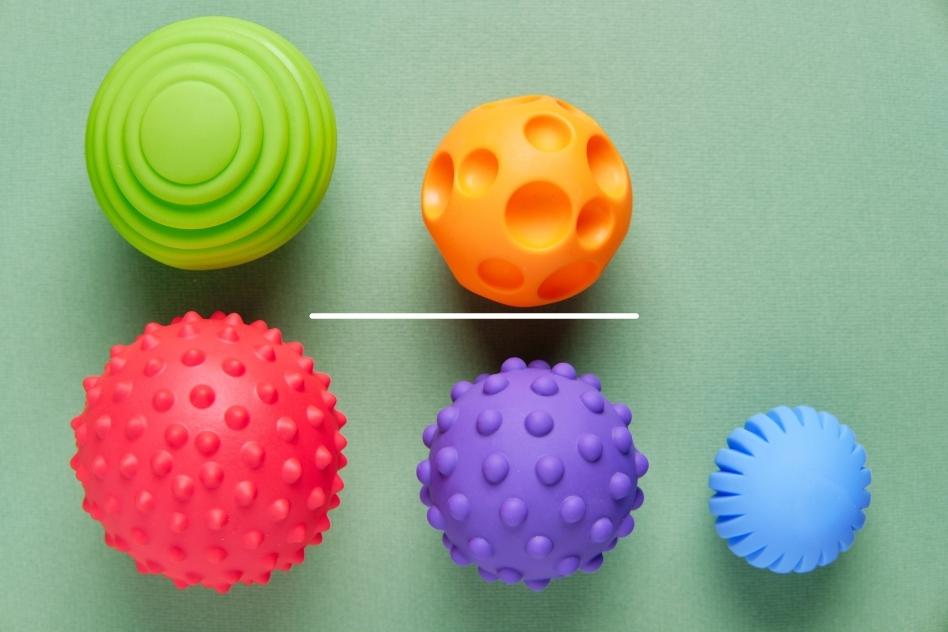
Best Montessori Toys for Babies 6-12 months
All the previous toys from 0-6 months stage will still entertain the baby, but it’s time to add some more advanced devices to your baby’s life.
1. Nesting Cups
Very timeless toy that will prove itself useful throughout toddler years as well. I personally love those ones, as they’re soft and multi-purpose. But, there’s also a simple version like these.

2. Object Fitting Puzzle
These puzzles may seem super simple to you, but they are helping baby build connections between the two brain hemispheres. They’ll use both sides of their body at once to put the puzzle pieces together (an important skill they’ll need for getting dressed later).
Ypu can either get a full set with a tray like this one, but if you’re looking for something smaller the egg one is sold separately as well.
3. Object Permanence Box
The permanence box is composed of a wooden box with a tray or drawer and a small ball.
The baby places the ball inside the box and watches it disappear for 1-2 seconds until it reappears, rolling on the tray. This toy helps them understand that an object exists even if they can’t see it for some time. They learn about an object’s permanence.
If not well designed, the ball can get stuck in the box and frustrate your child. So, choose your source carefully.
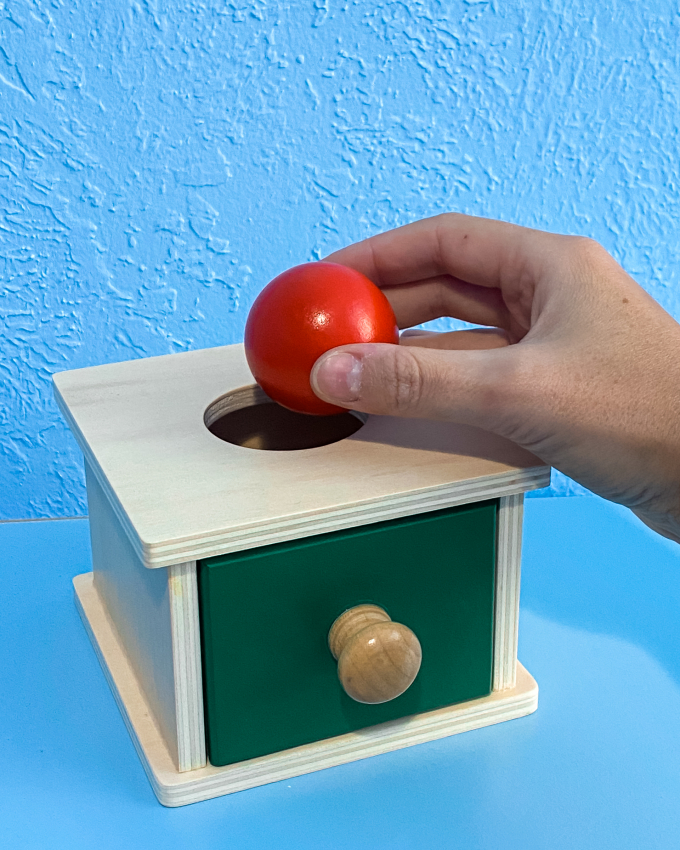
4. Multi-Shape Puzzle
Somewhere around 9 months, you can buy a 3-size circle puzzle or any variation of these.
If you want to give your child the most Montessori approach, choose puzzles that have one shape per puzzle – like these ones (I’m fully aware that even Lovevery doesn’t do the one shape per puzzle, but they aren’t 100% Montessori).
They should have large knobs, so your baby could easily grab them and position them in their right spot. Your toddler will learn about sizes and shapes, will exercise his fine motor skills like pincer grip, and will discover that each object has its right place.
If it’s too advanced, it may frustrate your baby, so start gradually. These types of puzzles evolve into more complex ones, that you can, later on, use for a toddler.
5. Pikler triangle
A big toy, but very worth it. Pikler triangles are the perfect space for your little one to practice pulling themselves up, climbing, and other gross motor skills and they can be introduced as early as your baby is beginning to pull up to stand – which we all know can be anywhere from 6 to 12 months.
I have a whole separate post explaining what to look for in a pikler triangle and what to avoid. Even how to make it yourself if you’re on a budget.
5. Spinning drum
The Montessori spinning drum is great for tummy time or sitting baby. It has small balls inside that keep rolling making a noise, but the colorful drum itself spins at a slow or fast pace – depending on the child.
It develops hand-eye coordination and helps your baby gain some strength.
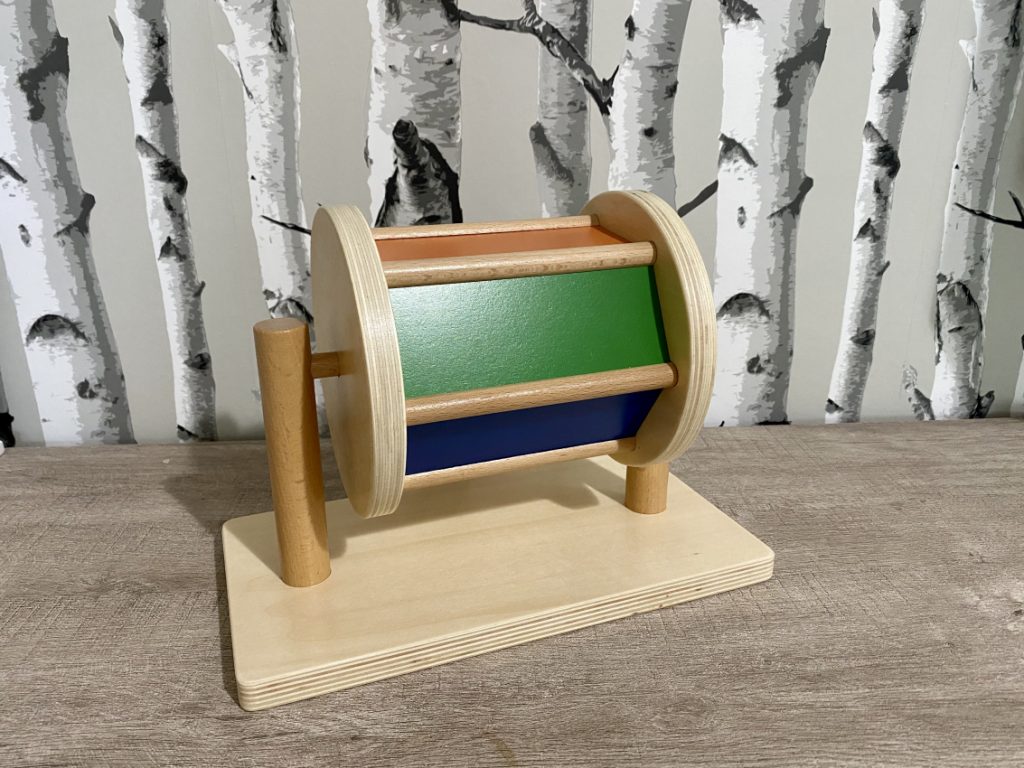
6. Wooden Hand Rattles
These are the rattles that can double as teethers and might help crawling is they can be rolled around on the floor. You can introduce them to anything from 3 months up and they can last for over a year as toddlers can also reuse them into instruments.
This is my favorite one as it folds and unfolds which makes it even more fun for the baby, but if you want a standard rolling one this is a great one.
7. Musical Instruments
This is a perfect time to introduce musical instruments to your baby. Playing drums, a xylophone, the maracas, or a rain stick – are great ways for your child to relax, learn about sounds, concentrate, relieve stress, and have fun.
On top of that, it is a sensory experience that will give pleasure to your baby. Not to mention the connection you build with your bub.
This one is the best and most economical wooden set.
While they play the instruments you can accompany them by singing along.
You can either let them explore the instruments independently or show them how to use it to make a sound, in case it’s a more complex one.
8. Anything making practical tasks easier for the baby!
I have a whole separate post on Montessori practical life items that your child will use for years. You can buy it as soon as you feel comfortable with it (as I know not all parents are cool with giving knives to smaller kids, even if plastic).
I will say that the learning tower is the most used item in our house. No day goes by when my toddler isn’t using it and he started with it as soon as he was able to stand.
While flashy electronic toys may seem like they hold a baby’s attention (and they’re great for road trips or when you need to run errands, I won’t lie about it!), ultimately you want to stock up on Montessori baby toys that really encourage learning. They’ll provide your baby with developmentally appropriate challenges to help them grow with more focus.


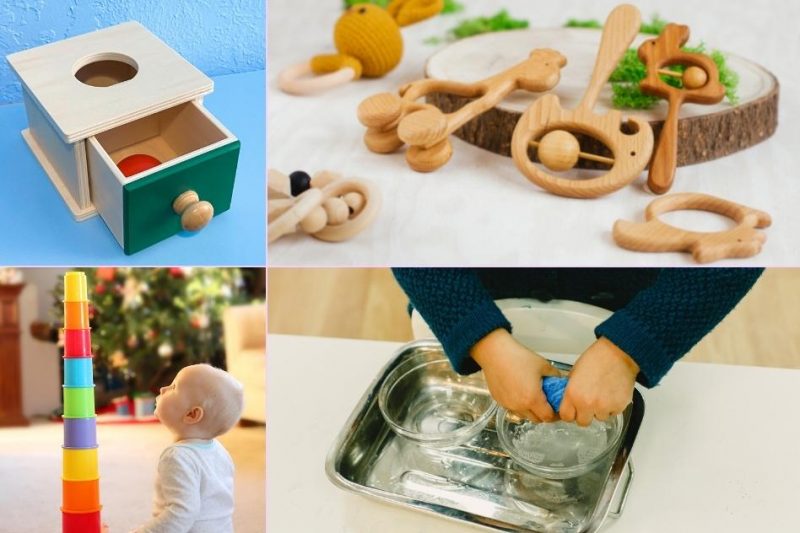

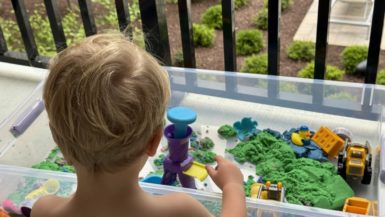

Fascinating to hear your perspective! The founder of MoniKids was my neighbor for years — lovely woman! — and it was a thrill to see her business grow. In general, the more Montessori play out there, I say the better!
No way, such a small world!
These are some amazing toys infact Stackers are my daughters favorite! going to try the wheel soon
That is some interesting perspective about toys. I never thought of it that way. I have seen some wooden toys in store and online but found them way more expensive. Its fascinating to know the impact of this on kids development.
Yep, plastic is super cheap to product and ship as well.